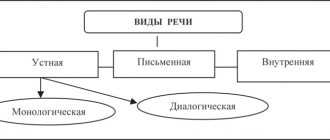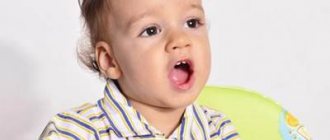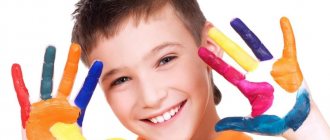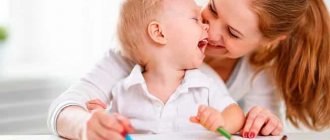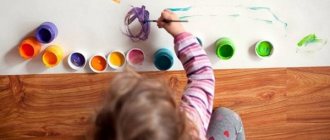Baby's speech
The baby's speech begins to form from the first moments of life. In order for speech development to occur harmoniously and evenly, parents need to become active participants in this process. Attention to the baby’s speech development will bear fruit soon enough when you see a little interlocutor next to you with whom you can have conversations on various topics. The development of a baby’s speech is facilitated by the daily joint work of parents and children.
Successful speech development of young children depends on certain conditions:
- Does the speech apparatus have a normal structure?
- How actively is the baby involved in communication with parents?
- Is the child’s fine motor skills developing?
It's no secret that all children's skills, starting from birth, are practiced in the form of play. The first games for teaching speech should be aimed at improving the speaking process through naming, onomatopoeia, storytelling and exercises for the development of fine motor skills. And for this it is necessary to provide the baby with not only necessary and useful toys and games (rattles, pyramids, cubes, multifunctional toys with inserts, plasticine and paints).
The formation of a child’s speech occurs, first of all, in the presence of active communication with him. It matters how exactly you explain to your baby the names of objects, phenomena and actions; how a child receives information about objects.
"Advice. In order for the baby to better remember the names of objects and actions, you need to verbalize (speak, explain in words) everything that happens around.”
How to determine that a child has speech delay
Delayed speech development is a later acquisition of oral speech in comparison with conventional norms for children under 3 years of age. Delayed speech development can be characterized by qualitative and quantitative underdevelopment.
In order to correctly understand how to determine delayed speech development, it is necessary to know the stages and conditional norms of speech development in children at an early age.
Normally, at 1 year of age, a child’s active vocabulary contains approximately 10 words, and the passive vocabulary contains about 200 words. Up to a certain time, the passive vocabulary is much larger than the active vocabulary. Approximately 1.6 - 1.8 months. words from the passive vocabulary burst into the active vocabulary. In some children, the period of passive speech lasts up to 2 years, although in general speech development is normal.
Deviations in speech development within the normal range are allowed for 2-3 months in girls, and 4-5 months in boys. Only a speech therapist can correctly understand whether a child has a speech development delay or not.
Signs of delayed speech development at different stages of speech ontogenesis may be: lack of response to sound and speech, inactive attempts to repeat other people’s words, absence of one’s own speech at different stages of its development, absence of non-speech methods of communication.
Causes of delayed speech development
Why did the child have a delay in speech development? Causes may include disturbances during intrauterine development and the birth process, as well as adverse effects that the child encountered in the first years of his life.
The most severe disorders occur during 3-4 months of intrauterine development. At this time, the fetal nerve cells form brain structures. The causes of delayed speech development in children associated with the course of pregnancy and childbirth can be factors such as early and late toxicosis of pregnancy, extreme prematurity, birth trauma, intoxication with chemicals and drugs. Delayed speech development may be influenced by genetic factors.
Pathologies during pregnancy and childbirth are not always the causes of underdevelopment. Sometimes disorders are caused by factors affecting the health and upbringing of the child - these are reasons of a biological and social order.
Biological factor . Biological factors include complications after vaccination, a slow rate of maturation of the nervous system, as well as long-term diseases that weaken the child’s immunity at an early age. The biological basis of RRD is most often the presence of minimal brain dysfunction in the child caused by perinatal brain damage.
Hearing loss. It is very dangerous if a child has reduced hearing or cannot hear anything. When hearing loss occurs, a child’s speech cannot fully develop. In this case, even minimal deviations from the norm can be considered the cause of RRD. It is very important at what age the baby lost his hearing. If this happened at 5-6 years old, the child can retain speech skills. When a child is born deaf or has hearing loss in the first years of life, the chances of such a child speaking are zero.
Social factors. Such factors include frequent stress, lack of attention and communication in the family.
Prevention
If parents notice that their child’s speech development is lagging behind the norm, then they definitely need to contact the right specialist. Neurologists, speech therapists, defectologists, and corrective teachers are working on solving this problem. In special cases, the help of a facial surgeon or orthodontist may be needed.
In case of impaired understanding of speech, incomplete mobility of the lips, tongue, low level of fine motor skills, if hearing impairment is suspected, the following studies are carried out: hearing test, examination of speech understanding, examination of fine and gross motor skills, examination of articulation organs, examination of vocabulary, examination of phrasal speech.
Based on the results of the examination, the degree of mental retardation is determined and corrective work is planned. How is delayed speech development treated? Drug therapy, magnetic therapy, electroreflexotherapy, dolphin therapy and hippotherapy are carried out; A teacher and proofreader works with the child.
With uncomplicated forms of pathology and with fully completed correctional work, by the time the child starts school, the delay in the development of the child’s speech will be overcome. To do this, it is important that parents support all the requirements and recommendations of specialists.
Measures to prevent speech delay:
- creating conditions for a favorable course of pregnancy and childbirth, the first years of a child’s life;
- the formation of a speech environment rich in educational toys and various objects;
- ensuring normal social conditions for the life and development of the child;
- assessment of speech development by a speech therapist no later than 2-2.5 years.
In order to quickly compensate for delayed speech development, you need to promptly pay attention to the child’s communication problems. There are several degrees and varieties of RRD, which only a specialist can diagnose. He will also find out the possible cause of the development of a speech defect affecting the central nervous system and brain.
Features of speech in early preschool age
Features of speech in early preschool age lie in the different stages of development of the baby’s speech.
Stage 1: screaming. The baby screams when he wants to report a problem, to attract attention to himself. Gradually, screaming becomes a means of communication, the first way to conduct a dialogue. By the third month, the baby learns to change the intonation of cries, by which attentive parents can understand what is causing the dissatisfaction: the child is grumbling, whining, something hurts, he wants to eat, etc.
Stage 2: buzzing. Humming is sound variations: drawn-out pronunciations of “agu”, “agi”, “gee”, “ge”, etc. With this type of speech, interaction is also important. By chanting sounds, the baby seeks contact and tries to build a dialogue. Parents should come into contact with the child, respond in a language he understands, introducing the first words into speech. The child will try to imitate you.
Stage 3: babbling. When the baby is 6-7 months old, he will begin to pronounce the first syllables: “ba”, “pa”, “ma”, etc. Gradually they will be repeated many times, which will precede the appearance of the first words.
“Did you know that humming and babbling are important manifestations of a baby’s speech, which prepare him for further speech development. If you do not see these manifestations, then they need to be stimulated. For example, holding the child close to your face, repeat the syllables clearly, recite poems and sing songs. Talk to your child more often using adult language.”
Stage 4: first words. As the child approaches the age of one year, it is important to help the child say his first words. You need to read aloud more, name all the objects around, comment on all actions. At this stage, speech therapists recommend training the muscles of the cheeks and lips - with the help of whistles, harmonicas and soap bubbles, as well as special articulatory gymnastics (simply put, making faces and depicting emotions).
An important point in the development of the speech of younger preschoolers is the appearance of onomatopoeic, simplified words (“av-av”, “lyalya”, “bibika”, etc.). It is currently difficult for your child to pronounce words correctly, but later, with your help, he will learn to name objects and actions correctly.
Ways to develop speech in young children
Game activity as a means of speech development
Play is of great importance in the development of speech in young children. They love to play short outdoor games that help develop their speech. The more children enjoy the game, the more effective the result will be.
Play develops language, and language organizes play. The word is part of reality for the child. It is very important to properly organize the play environment, combining the interests of children and objects that will help in the development of speech.
Passive vocabulary is words the meaning of which a child understands, but does not speak due to age or due to delayed speech development. Children pronounce words and sounds as they hear them.
Games and exercises for developing passive vocabulary:
- "Errands." Choose a toy that is in front of the child and ask him to perform some action with it. For example, brush a doll’s hair, feed a teddy bear.
- "Do It". Ask your baby to clap his hands, jump, squat, spin, raise his arms up, close his eyes, open his mouth, etc.
Speech games aimed at developing vocabulary:
- "Balls and cubes." Offer to match items by color and place them in baskets. It is necessary to mark the color on the basket.
- "Big small". It is suggested to put large cubes and large balls in a large basket, and small ones in a small one.
- "Wonderful bag." Consider toys with your child: cubes, balls, be sure to pronounce their shape, and then hide them in a bag. Then the child must determine the shape of the object by touch and pull it out.
Speech development with the help of fiction
Fiction has a huge impact on the development and enrichment of a child’s speech.
A child’s first acquaintance with fiction begins with nursery rhymes and songs, then he listens to folk tales. A journey into the world of a fairy tale develops the imagination of children, and encourages them to write.
The book is considered as a means of developing children's speech and improving its content. She provides the child with mental and moral education.
Poetry
As you know, the easiest and most effective way to teach a child is through play. This is also true for situations where you need to practice the correct pronunciation of sounds. An interesting author’s technique for developing pronunciation and preparing a child for reading is described HERE: “Interesting games for 3-year-old children”
Speech therapy rhymes are a great way to practice if your child is unable to pronounce a particular sound. You can start learning these poems as early as 2–3 years old.
Speech of children 3-4 years old
In 3-4 year olds, speech develops quite quickly. Usually, by the age of three, a child practically masters his native language. The vocabulary of three-year-olds is growing every day: up to 100 new words come into use per month. A four-year-old child already has a vocabulary of about 2 thousand words. In children of this age, the sound design of words becomes better, phrases sound more developed. It should be noted that not all children develop in the same way. Some children have some delay in speech: they speak unclearly, words and individual sounds are pronounced incorrectly. Children often shorten words, skip and rearrange sounds and syllables. The speech of three-year-old children is of the same type and simple. However, even at such an early age, children show interest in words.
Article:
Younger preschoolers have unique characteristics in the development of speech: their psyche is especially sensitive to language, to its semantic and sound aspects.
Language enrichment occurs as a result of performing new tasks that arise during communication and during one’s own activities. All this creates the prerequisites for the further formation of speech. Speech development in younger preschoolers
The purposeful development of speech in younger preschoolers is one of the leading areas of pedagogical activity, ensuring the timely mental development of children. Speech is the basis of the human mind, the crown of nature’s creation; from early childhood, human life is connected with language.
In the development of a child’s speech, the leading role is played by adults: the family (parents) and the kindergarten teacher. The child’s success in mastering the language depends on the culture of speech of adults and how they talk to the child, how much time they devote to verbal communication.
Thus, an adult’s speech must comply with the norms of literary language and literary colloquial speech both in terms of the sound aspect (diction, tempo, pronunciation of sounds and words) and in terms of the richness of the vocabulary, accuracy of word use, grammatical correctness and coherence.
The main goal of speech development of young children:
- formation of oral speech and verbal communication skills
- Main tasks of speech development:
- formation of a dictionary
- development of sound culture of speech
- development of grammatical structure of speech
- development of coherent speech
- introducing children to fiction.
When developing speech, you need to take care not only that the child pronounces as many words as possible, but also that the heard and spoken words are supported by living images and specific content. And to do this, you need to not only talk with the child about this or that, but also introduce him to the real world of things, phenomena, events. It is necessary that he sees what they are talking about with his own eyes, hears with his own ears and, if possible, acts with his own hands. During this period, the baby is especially interested in the names of objects and phenomena, and every now and then he asks adults the question: “What is this”? Take advantage of this favorable moment, communicate more with your child, thus accumulating his passive vocabulary.
You can and should talk to a 2-3 year old child about things that are not currently in his field of vision, for example, what he saw this morning on a walk or even some time ago. This develops his speech, trains his memory, teaches him to listen to other people’s speech and understand it.
More often, look at various pictures with a plot that he understands with your child, discuss them, and come up with short stories. In this case, the adult must give the child a sample of correct speech.
If a child pronounces any sounds or words incorrectly, you should not laugh or imitate him. You cannot scold your child for poor speech and demand that he immediately and correctly repeat a word that is difficult for him. This will lead to the child trying not to use some words at all or replacing them with others. Do not imitate your child by repeating words he pronounces incorrectly. And there is no need to try to point out to the child that this is wrong. It is better to repeat the word after the baby, but pronounce it clearly so that all sounds can be heard.
Speech development in children 3-4 years old occurs especially quickly. As a rule, by the age of 3, a child almost masters his native language. The active vocabulary of children from 3 to 4 years old grows literally by leaps and bounds, up to about 100 new words per month. If at three years old a child needs a few hundred words to communicate, at four years old this figure reaches 1.5-2 thousand words. At the same time, we must remember that in a family, adults use an average of 3 to 5 thousand words for everyday communication.
The sound design of words also improves quickly, and phrases become more developed. However, not all children have the same level of speech development: some pronounce words clearly and correctly by the age of three; others do not speak clearly enough, pronounce words incorrectly; Still others speak insufficiently clearly and pronounce certain sounds incorrectly. The most typical mistakes are omission and replacement of sounds, rearrangement of sounds and syllables, violation of the syllabic structure (abbreviation of words - “tamva”, instead of tram, incorrect stress).
The speech of three-year-olds is the same. They pronounce all verbs in the present tense. The baby's understanding of the past or future is still limited. The sentences are similar to each other: the subject comes first, then the predicate, then the object. Kids easily perceive simple nominal sentences. At this age, children develop a special interest in words. Kids try to establish the meaning of words, their origin, create their own words (a mug instead of a spring). The baby is attracted by the sound design of words, and he even tries to correct poorly speaking peers, although he still cannot determine which sound or often the word is pronounced incorrectly.
The child cannot yet independently determine what sounds a word consists of, establish their sequence, or decompose the word into parts (syllable sounds).
The main directions of work on speech development in the second junior group are as follows:
Expanding children's vocabulary
Development of sound culture of speech
Development of grammatical structure of speech
Development of coherent speech (monologue and dialogic)
Development of figurative speech
The main forms are the organization of educational situations and communication situations. Teachers organize educational situations - looking at pictures, toys, reading fairy tales and short stories, learning poems. Their goal is to teach children the ability to compose stories, tell fairy tales and act out them, the ability to ask questions and retell heard content, and compose their own story based on the listened content. We organize this educational situation at any time of the day - in the morning, in the evening, during a walk with one or more children. We repeat one situation several times with different children. Communication situations most often arise spontaneously, and teachers see and support such situations. They try to grasp the meaning of the child’s statement, which often consists of one or two short phrases, and with their questions encourage the child to engage in dialogue or a more complete statement.
An important role in the development of a child’s speech belongs to the artistic word. Kids love poetry very much. They are pleased with the rhythm of the verse, they enrich children's experiences, develop thinking, and awaken a love for the literary word and their native language.
Poems, nursery rhymes, jokes, accompanied by playful activities, delight children.
Kids need to read short poems, simple ones, with images that are understandable to the child (poems by A. Barto from the “Toys” series). They have access to the simplest fairy tales - “Ryaba the Hen”, “Turnip”, “Teremok”, “Kolobok”. Children of this age perceive vividly, quickly remember and begin to repeat what they like.
More opportunities for speech development open up while walking with your child. Bright summer sun or fluffy snowflakes - all this attracts a child and can serve as a topic for conversation with him.
When looking at pictures in books and magazines, name and explain to your child everything that he sees in front of him. Repeat the desired word several times, ask to see the object you named, and then ask him to name the word himself. Be sure to praise your baby and celebrate his successes.
Draw your child’s attention more often in everyday life to the colors of objects, ask leading questions: “What color is your blouse? What about the boots? When your child draws, be sure to highlight with a pencil what color he is drawing.
There is a close connection between speech development and the development of gross and fine motor skills. Therefore, we recommend that you constantly use fine motor skills games when communicating with your child - stringing beads and buttons on wire, using finger games, finger painting, sculpting from plasticine, salt dough, clay. Games with cereals, with shells of seeds, nuts, large fruit seeds. Try putting together large puzzles and describing the picture that will come out.
Environment for speech development
For successful speech development of a child, it is necessary to create conditions that would contribute to the formation of good speech skills. Such conditions can be created both in a preschool institution and in the family. The developmental environment will provide different types of activity for the younger preschooler (speech, mental, physical and play) and will successfully form his independent speech activity.
So, what needs to be done to create a cozy environment at home, rich in a variety of educational gaming and educational materials?
- At home, conditions must be created for the baby’s independent activity - for play, cognition, movement, imagery.
- Items in the child’s room should be suitable for the baby’s age and correspond to his interests and needs.
- At home, communication between the child and adults should be organized.
- Parents should help organize the child’s contacts with peers.
- Mom and dad should offer the child books, pictures, toys, and objects for independent study in order to deepen knowledge about the world around them.
- You can organize a “corner” of interesting things with didactic materials that encourage speech activity.
- Parents should not only actively communicate with the child, naming all actions, but also read and study in the direction of speech development.
Thus, a well-prepared developmental environment will contribute to the formation of speech skills of younger preschoolers and will ensure their independent natural speech development.
Conclusion on Chapter I
From the very first days of life until the end of the preschool period, children have the most important task - the formation and development of speech. Each year of a child’s life is divided into stages and at each of them speech is improved - from the first infant cry to the composition of complex sentences.
During early childhood, children undergo intensive speech development. During this time, the child’s active vocabulary exceeds the passive one; the child learns that each object has its own name; after he hears the word, he tries to repeat it; he learns to compose simple and complex common sentences.
The development of a child’s speech is closely related to communication with adults, and a lack of this communication can lead to delayed speech development and also affect the development of the baby’s psyche. A child’s communication with the people around him allows him to increase his passive and active vocabulary, improve his pronunciation and the content of his speech.
We walk and talk
You can develop the speech of younger preschoolers on walks. Such “activities” are very natural, bring children a lot of impressions, and contribute to their knowledge of the world. While walking, the baby will begin to ask a lot of questions, many of which encourage the thought process and require the expression of emotions and thoughts using words. And all parents can do is communicate with the child, expanding his vocabulary, enriching his knowledge. This is how the child learns new words and concepts that will soon become mandatory in his everyday speech. Don't be afraid that the baby won't understand you. During these valuable moments of communication, the baby listens and learns to perceive his native speech.
“Did you know that walking is one of the most effective ways to develop a child’s speech? All that remains is to organize it correctly.”
During the walk we recommend:
- describe everything that surrounds you
- keep your baby interested in what is happening around him
- use different parts of speech to name objects, their signs and actions
- speak emotionally and intonation richly, in a calm tone.
Educational didactic games
At the age when the child gradually moves from babbling to words (1.5-2 years), you can start playing useful didactic games with him for speech development:
- “What object is this?” The mother takes the prepared toy out of the bag, describes it, and then offers to describe it to the baby.
- “Guess what toy.” There are 3-4 toys in front of the baby. Mom describes one of them, and the baby guesses it from the description.
- “Describe the doll.” The mother invites the child to describe the doll in detail.
- "Mystery Box" Mom put themed pictures in a bright box in advance. The kid takes out one picture at a time and describes what he sees.
- “Tell me what object?” The child takes toys out of the box and names their characteristics (adjectives).
- "Wonderful cubes." The baby throws a dice with pictures. The red picture appears - the child says what he sees and gives a description of the depicted object.
- “Where is the toy?” The mother lays out toys in the room and invites the child to name where each of them is located. Mom should tell the baby how to correctly use the words “in”, “on”, “behind”, “under”, “about”, “next to”, “between”, “right”, “left”.
- "Postcard". The mother shows the child postcards with images of people and animals performing different actions. The child must name what action is depicted on the postcard.
These games are suitable for children from 1.5 to 4 years old. There are many such games. Parents, if desired, can come up with them themselves, making activities with their baby enjoyable leisure time, full of the joy of new discoveries.
